Welcome to issue #10 of Susanality, a free weekly newsletter. Thanks for being here! If you’re loving this newsletter, please consider a paid subscription. Having your support would mean a lot to me, as I continue to work hard to bring you fresh content on a weekly basis. Additional posts and recipes will be going out to paid subscribers at least twice a month, and more features are coming soon!
Do you use recipes on a regular basis and like to follow them slavishly so you can learn to be a better cook while someone (like me) is holding your hand? Or are you the type who gets ideas from recipes and then does your own thing? Or maybe (like me) it’s your JOB to create and write recipes. Whichever scenario is yours; we’ve all been dealing with recipes and cooking A LOT.
If there’s one thing we’ve learned this past year in the kitchen it’s how to be adaptable. And we’ve all had to pivot and swap out an ingredient or two because either we didn’t have it in the house, or we ventured to the store (which has become much less scary lately) and they didn’t have it. The shortages have been random, but real. Even now, more than one year out, stores still don’t have everything, every day. And that’s OK. Because we have learned how to pivot. And you know what? Everything still turns out OK, quite often just as good, and maybe sometimes better.
I heard a quote this week on a podcast and it really resonated with me. It was quoted by Douglass Williams, the chef and owner of MIDA in Boston. I don’t know where the quote originates from, but it’s a good one. Douglass said, “A recipe is a guide, not a god”. If you don’t already know this and live by it, think about it. Even as a person who writes recipes for a living, and wants you to read them, I want you to keep this idea in mind.
I went to my local grocery store to gather some ingredients I needed for this week’s recipe. The supermarket is a small IGA in Amagansett, NY, which has been remarkably well-stocked throughout the pandemic. But They. Were. Out. Of. Frozen. Peas. I wasn’t even hoping for fresh peas. A) They aren’t necessary for this recipe. B) I am too lazy to shell peas for an easy recipe like this C) Frozen peas are often better than fresh ones you’d find in the supermarket. So, as I rummaged around in the freezer, sad because I was going to have to get back in the car empty-handed and go elsewhere to find peas, I suddenly saw A. Big. Bag. of Frozen. Fava. Beans. This is not something I have seen frozen before, so I was kind of excited in general and excited to try them in this recipe.
Favas are similar to peas in many ways, but mostly because they are bright green and starchy enough to form a creamy sauce when some pasta water is added. They do have a different flavor; if you are a pea-hater, this would be a good option for you. I was eyeing the edamame until I saw the favas, and I imagine they would work too. I wasn’t sure what to expect from these frozen favas, which still needed to be blanched and peeled, but I am happy to report that they were pretty excellent. There were a few yellow ones I threw in the compost pile, but mostly they were bright green and really fresh-tasting, so it was a win! And I still have half a bag left to add to another dish. If you’ve ever shelled fava beans, you know they are a lot of work for a really small yield, which is why I always order(ed) them in restaurants when they’re on the menu. I love them, but I am not always willing to do all that work. The frozen ones cut that work in half, because you only need to peel them, which is easy and kind of fun because you squeeze them and they pop out! The favas work beautifully in the pesto you’ll find below.
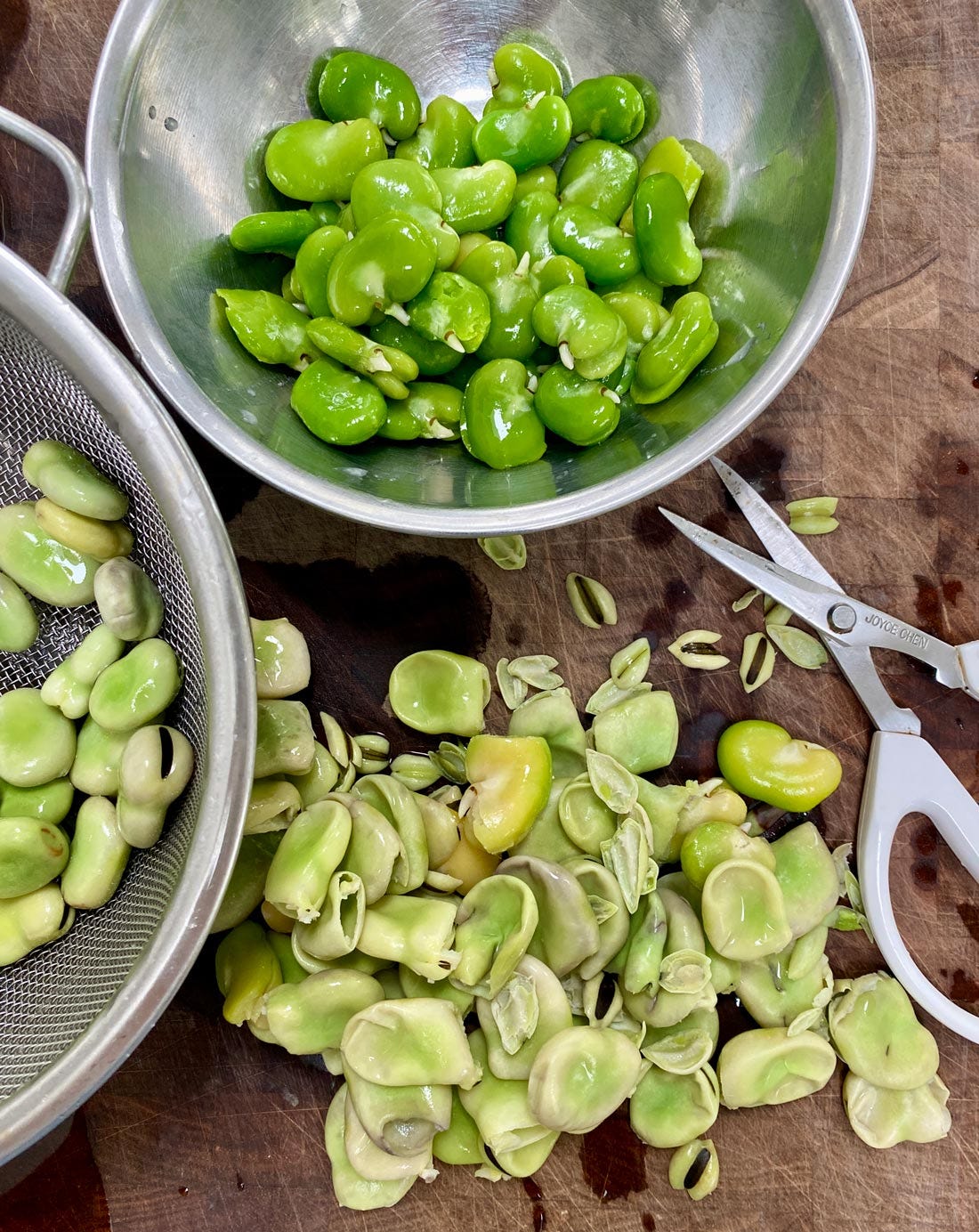
Back to the podcast. I wanted to listen to this particular episode of The Splendid Table, because I saw that Dan Pashman of the Sporkful podcast was a guest. Pashman recently invented a new pasta shape called Cascatelli which is really unique and craveable, and that story is fascinating. But what I was really interested in was bucatini because I wanted it for this recipe, and I had heard that it had become kind of… controversial. I was curious to see if there would be any discussion of this polarizing pasta shape, and there was! In case you don’t know, bucatini is basically a thick spaghetti with a hole in the middle. I’ve always liked it, but it is not always available, and it has even been the victim of a much discussed pandemic shortage. Some people love it, and others hate it. You’ll have to listen to hear a deep dive on the reasons why.
But here’s the thing about this recipe — and any other that calls for something you don’t have or don’t like. Substitute with something you DO have or DO like! It’s totally fine.
PS - I wanted to remind you that all of the recipes in my newsletters live permanently here. You can also scroll through public recipes on my site or keep up with me on Instagram. Or better yet, you can support me by ordering my book, Open Kitchen.
Bucatini with Pea Pesto and Shaved Asparagus
Click here for a printable version
Serves 4
This simple and Spring-y pasta is easy to put together and requires no cooking beyond boiling the pasta. It doesn’t even require any chopping! The shaved asparagus is done with a vegetable peeler, and the delicate curls turn satiny and soft from the warmth of the pasta. This recipe makes four dinner portions, but if you are only cooking for two, use half the amount of pasta. You can halve the pesto too, but it’s a small amount for a food processor, and it will keep a few days, so I suggest you make the whole thing and use the pesto for other things, like seasoning vegetables, as a sandwich spread, or as an omelet filling.
1 cup fresh or frozen peas, thawed (or peeled fava beans)
1 clove garlic (or 1 stalk green garlic)
½ cup Pecorino Romano or Parmigiano Reggiano (or a combination), plus more for serving
1 cup loosely packed herbs, such as mint, basil, and/or parsley
¼ cup extra virgin olive oil, or more as needed
½ teaspoon kosher salt
Freshly ground pepper, to taste
Red pepper flakes, to taste
Zest and juice of 1 lemon
1 cup fresh ricotta
8 ounces asparagus, shaved with a vegetable peeler
1 pound Bucatini or thick spaghetti
Combine the peas, garlic, cheese, herbs, oil, salt, and pepper in the bowl of a food processor. Pulse until a coarse puree is formed. Add more oil as needed to loosen. Set aside.
Cook the pasta in well-salted water until al dente. Scoop up a cup of pasta water and drain the pasta. Return the pasta to the pot and toss with the pea mixture. Loosen with some pasta water and bring to a boil, tossing the pasta. You should have a creamy, but not watery sauce. Season to taste with salt and red pepper flakes.
Divide among four warm bowls and grate the lemon zest over the bowls. Squeeze the lemon over each serving. Dollop the ricotta over each serving, and top with the asparagus. Serve more grated cheese on the side.
An update on last week’s subscriber-only recipe for The Greenest Vinaigrette and Spring Potato Salad.
My good friend Maya Kaimal took one look at the potato salad recipe, and adapted it, giving it an Indian spin. She said she was inspired to try something like it, but with more of an Indian green chutney. She turned her usual cilantro mint chutney into a vinaigrette by using rice vinegar and olive oil in place of yogurt and lemon juice. If you want to try it, here’s the “recipe”: A bunch of cilantro, half a bunch of mint, a little white onion, garlic, ginger, serrano chili, cumin, salt, pinch of sugar, plus rice wine vinegar and olive oil. Sounds and looks great, doesn’t it?

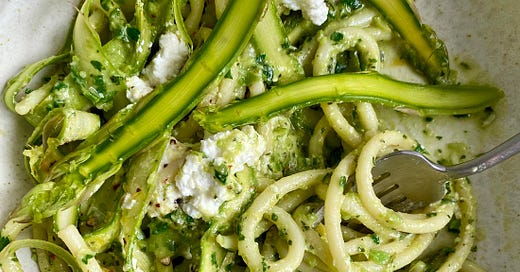


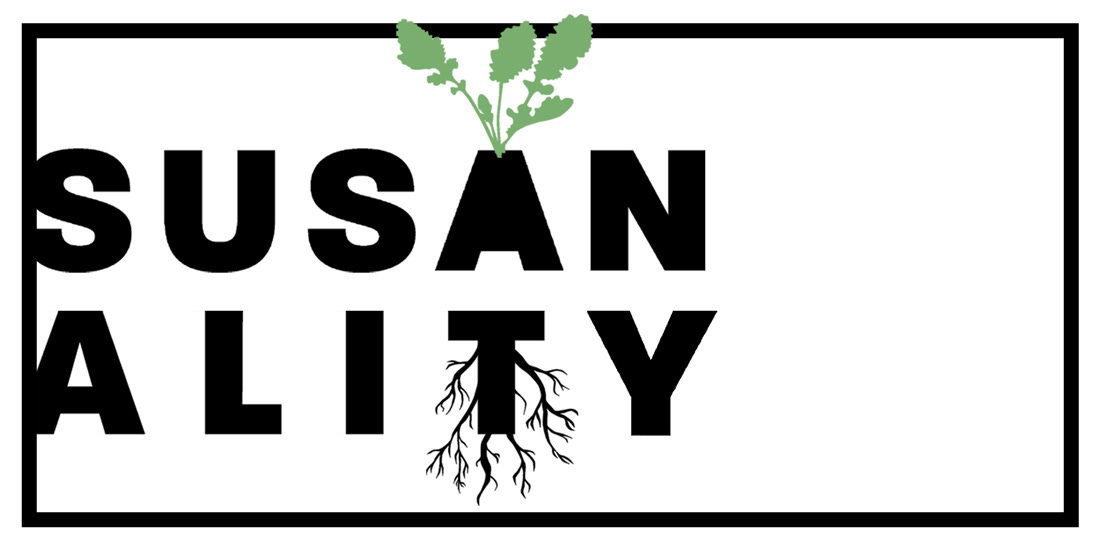
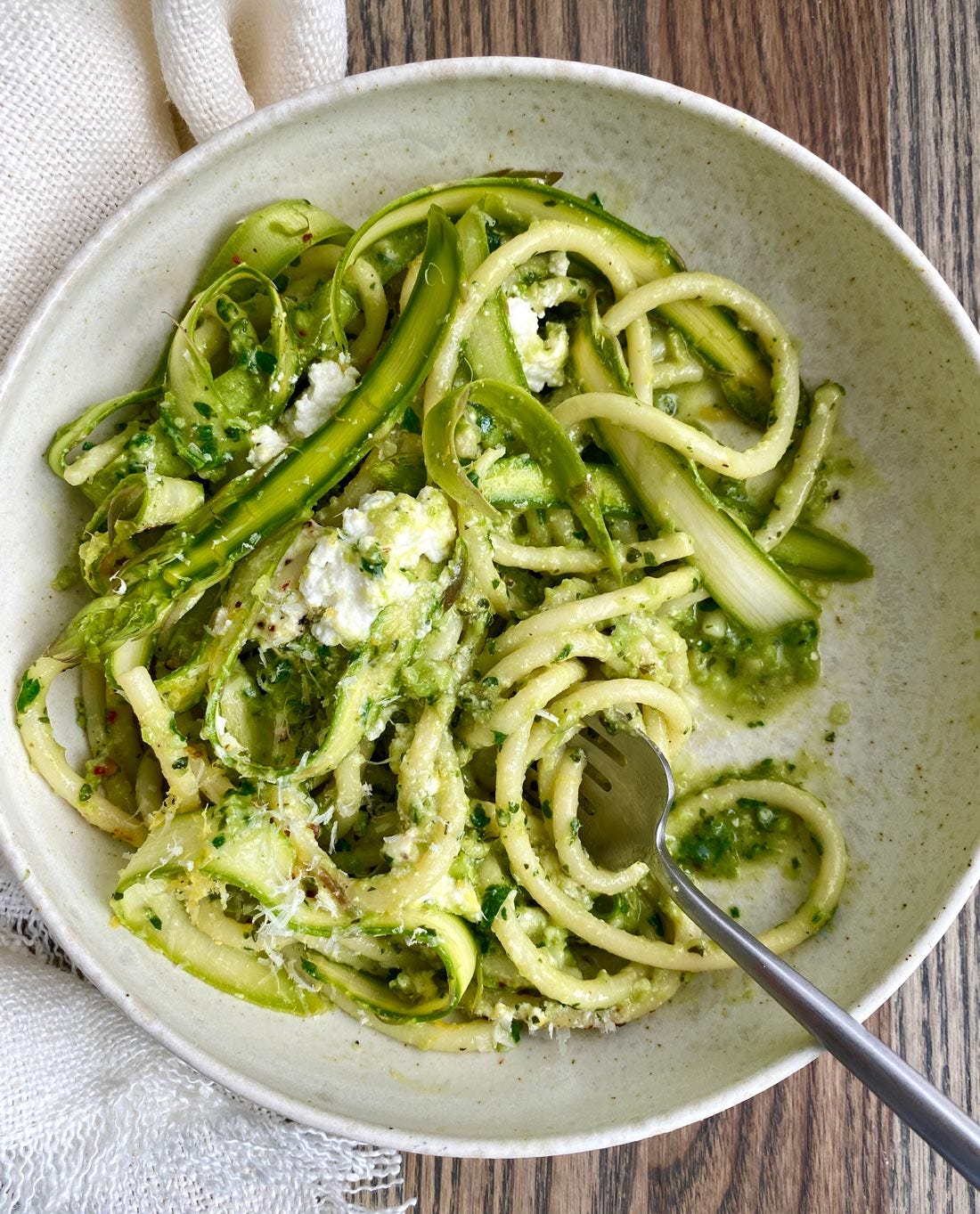
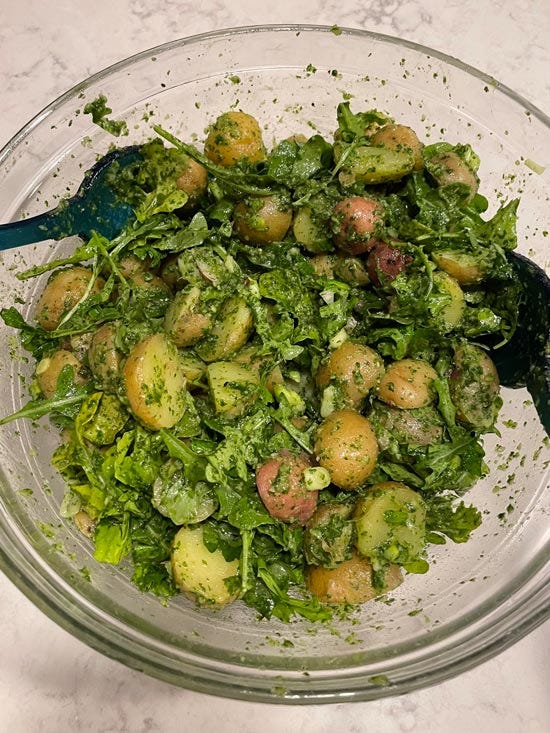
Love your exceptionally creative recipes . . . most all of them!